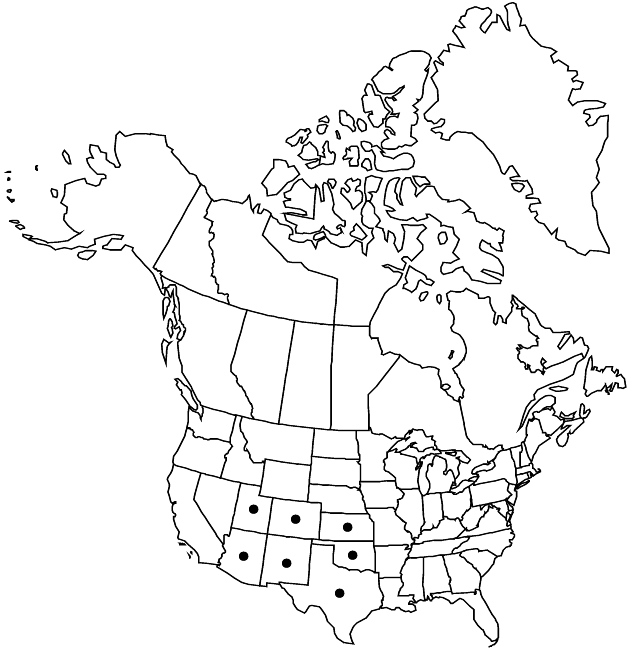Difference between revisions of "Lorandersonia baileyi"
Sida 21: 1621. 2005.
FNA>Volume Importer |
FNA>Volume Importer |
||
| Line 11: | Line 11: | ||
|name=Chrysothamnus baileyi | |name=Chrysothamnus baileyi | ||
|authority=Wooton & Standley | |authority=Wooton & Standley | ||
| + | |rank=species | ||
|publication_title=Contr. U.S. Natl. Herb. | |publication_title=Contr. U.S. Natl. Herb. | ||
|publication_place=16: 181. 1913 | |publication_place=16: 181. 1913 | ||
| Line 17: | Line 18: | ||
|name=Chrysothamnus pulchellus subsp. baileyi | |name=Chrysothamnus pulchellus subsp. baileyi | ||
|authority=(Wooton & Standley) H. M. Hall & Clements | |authority=(Wooton & Standley) H. M. Hall & Clements | ||
| + | |rank=subspecies | ||
}} | }} | ||
|hierarchy=Asteraceae;Asteraceae tribe Astereae;Lorandersonia;Lorandersonia baileyi | |hierarchy=Asteraceae;Asteraceae tribe Astereae;Lorandersonia;Lorandersonia baileyi | ||
| Line 41: | Line 43: | ||
-->{{#Taxon: | -->{{#Taxon: | ||
name=Lorandersonia baileyi | name=Lorandersonia baileyi | ||
| − | |||
|authority=(Wooton & Standley) Urbatsch | |authority=(Wooton & Standley) Urbatsch | ||
|rank=species | |rank=species | ||
| Line 56: | Line 57: | ||
|publication year=2005 | |publication year=2005 | ||
|special status= | |special status= | ||
| − | |source xml=https://jpend@bitbucket.org/aafc-mbb/fna-data-curation.git/src/ | + | |source xml=https://jpend@bitbucket.org/aafc-mbb/fna-data-curation.git/src/eaa6e58056e40c9ef614d8f47aea294977a1a5e9/coarse_grained_fna_xml/V19-20-21/V20_388.xml |
|tribe=Asteraceae tribe Astereae | |tribe=Asteraceae tribe Astereae | ||
|genus=Lorandersonia | |genus=Lorandersonia | ||
Revision as of 19:28, 16 December 2019
Shrubs, 25–70 cm. Stems single, greenish when young, becoming whitish to gray, fastigiately branched distal to middle (angled from leaf bases), glabrous or puberulent. Leaves ascending to appressed; blades linear or linear-oblong, 4–35 × 0.5–3 mm, flat or adaxially concave, margins ciliolate, midveins evident, often purplish, apices acute to acuminate, faces glabrous. Heads usually in cymiform to corymbiform arrays 0.5–7 cm wide, sometimes borne singly. Involucres obconic to cylindric, 10–15 × 4–6 mm. Phyllaries 20–25 in 4–5 series, in 5 vertical ranks, mostly tan, shiny, with green subapical patch, midnerves mostly evident on distal 1/2, keeled, ovate to oblong or lanceolate, 1–10 × 0.8–2.3 mm, unequal, mostly chartaceous, margins entire, narrowly scarious, apices acute to attenuate or acuminate, faces glabrous. Receptacles with 0–1 central awn ca. 0.5 mm. Ray florets 0. Disc florets 5; corollas 9–14 mm, glabrous, lobes 1–1.7 mm; style branches exserted, 4.1–4.6 mm, appendages narrowly triangular, 2–2.8 mm. Cypselae brownish, turbinate, 5–7 mm, sharply 4-angled, 5–8 ribbed, faces sparsely or rarely densely hairy; pappi yellowish tan, 9–12 mm. 2n = 18 [as Chrysothamnus pulchellus].
Phenology: Flowering late summer–fall.
Habitat: Open high plains, especially in sandy sites
Elevation: 1300–2400 m
Distribution

Ariz., Colo., Kans., N.Mex., Okla., Tex., Utah, Mexico (Chihuahua, Coahuila).
Discussion
Lorandersonia baileyi is often treated as a subspecies of L. pulchella. Phylogenetic analyses (R. P. Roberts and L. E. Urbatsch 2004) indicate that the two are not sister taxa.
Selected References
None.